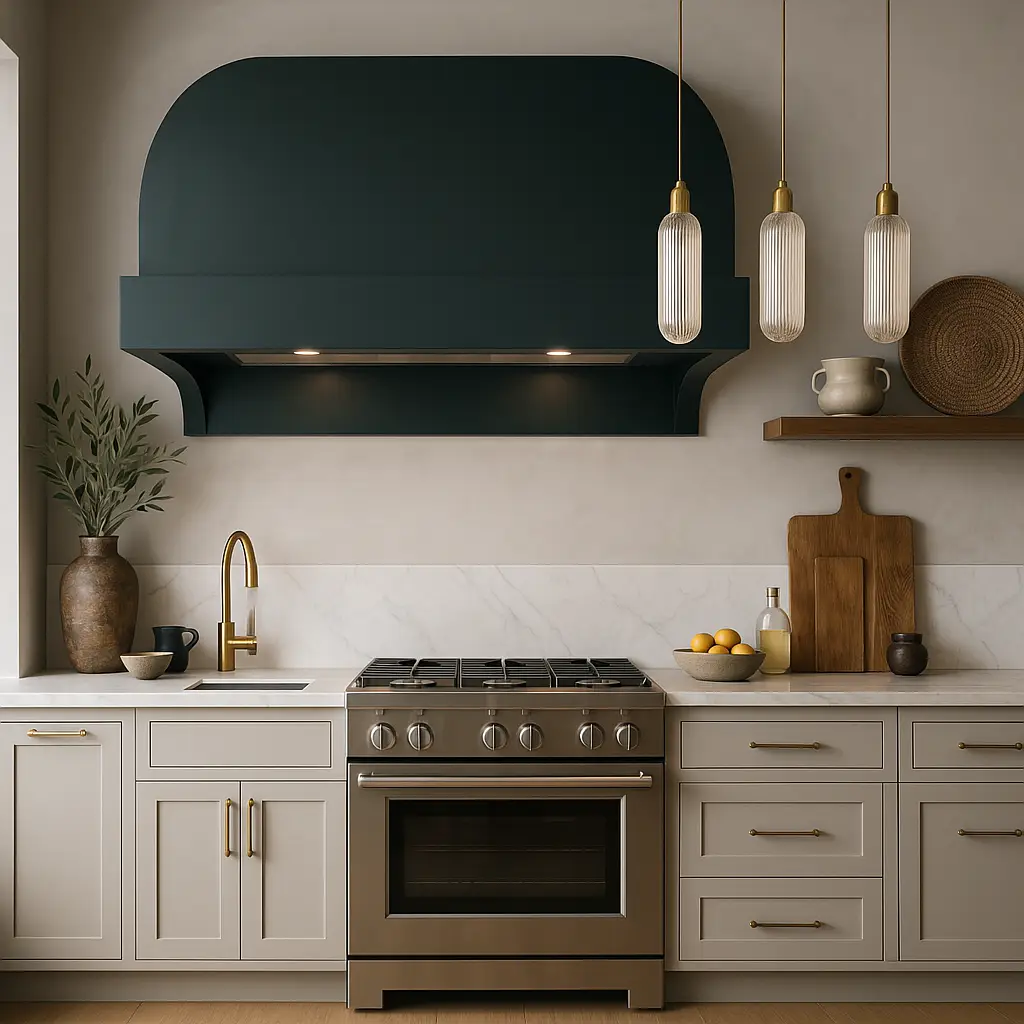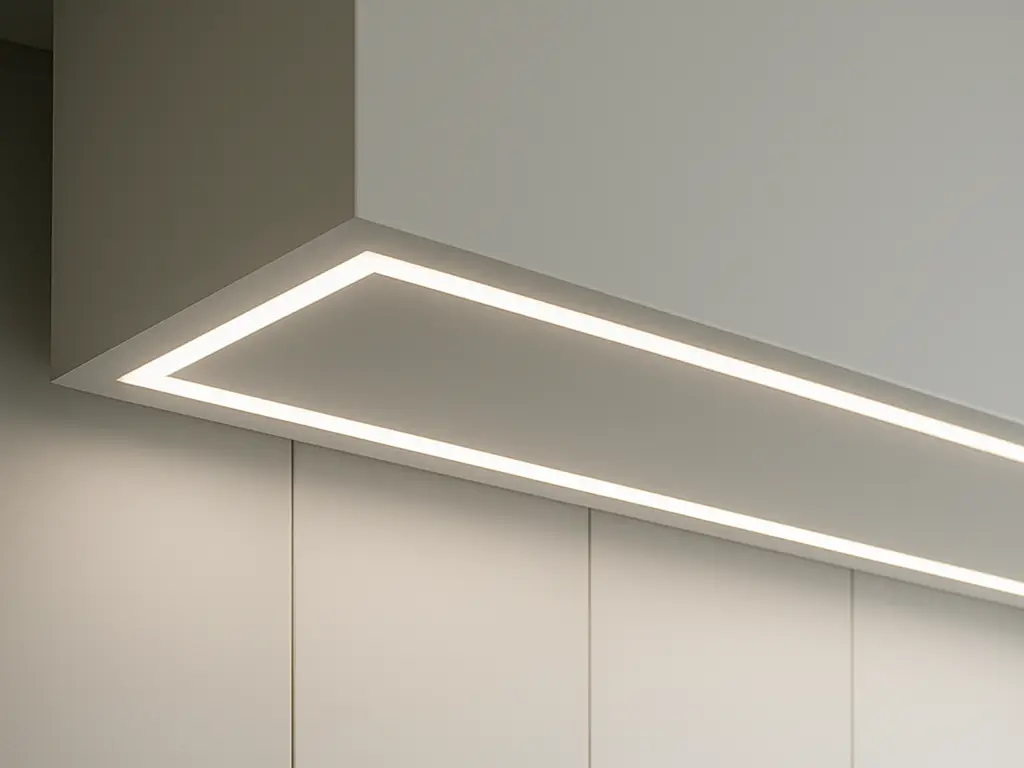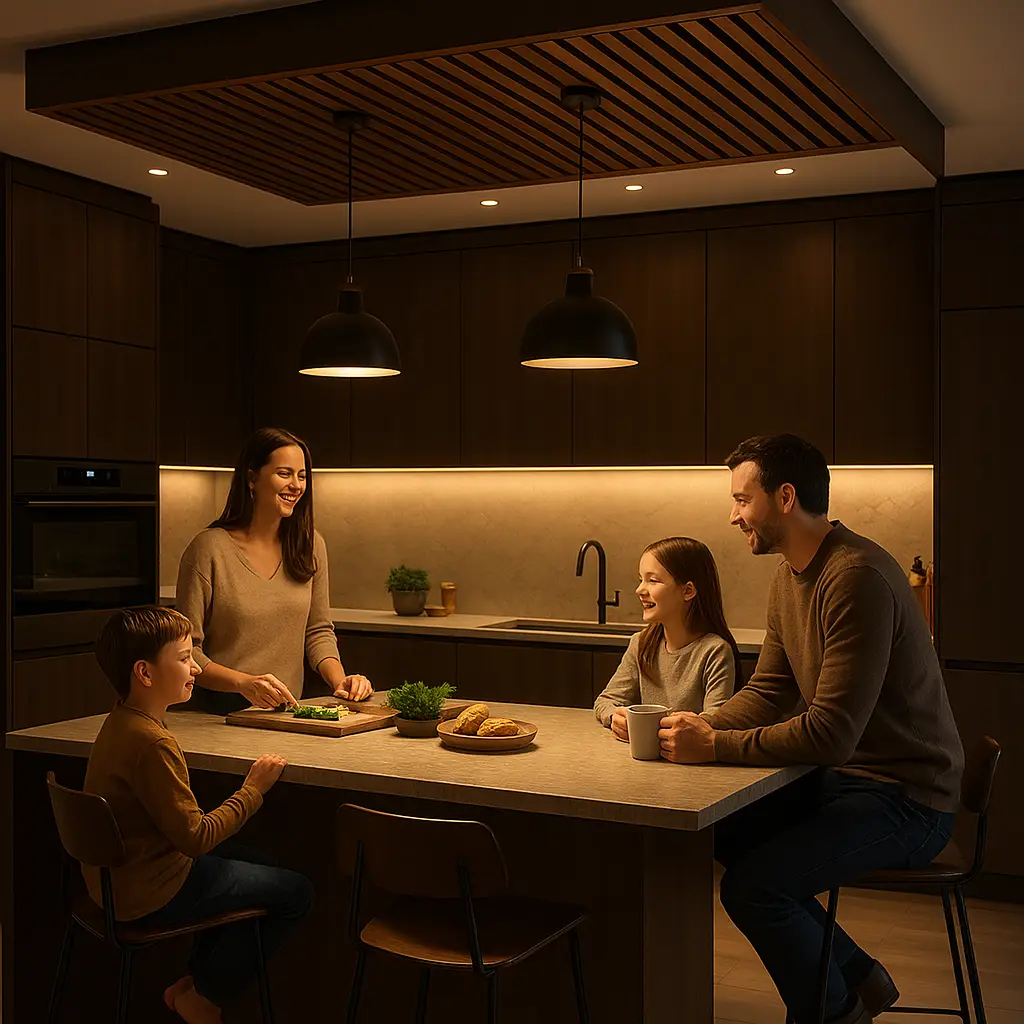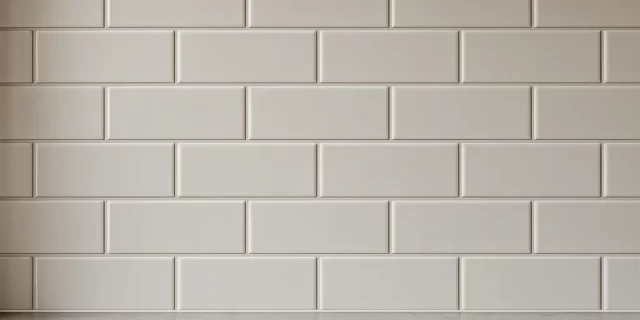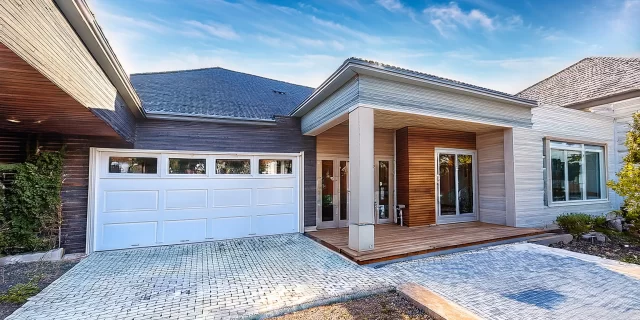Key Takeaways
- Kitchen bulkheads can be incredibly attractive & functional design elements, as seen here. They hide recessed wiring, plumbing, and ductwork, giving your kitchen that clean, streamlined appearance, while providing additional kitchen storage.
- Bulkheads offer greater design flexibility than soffits. They really keep your eye moving and help you design seamless transitions between upper cabinets and ceilings, making for a very cohesive aesthetic.
- Introduce new elements such as built-in lighting, advanced technology, or textured materials. Incorporating these elements will ensure your kitchen bulkhead looks great and serves a purpose, making your kitchen an eye-catching modern standout space.
- Bulkheads strongly assert boundaries in open-concept floor plans. They add functional visual separation without cutting off the natural flow between kitchen, dining, and entertaining spaces.
- Thoughtfully designed bulkheads can increase your home’s value by maximizing vertical space, improving storage, and showcasing unique design elements like bold colors or built-in shelving.
- So instead, proper planning is key. Consider your overall kitchen configuration, price point, and fabrication material options. Afterwards, enlist the help of professionals to go over things like adequate ventilation, accessibility, and your local building code specifications.
What is a Kitchen Bulkhead?
A kitchen bulkhead can be utilized as a design element. Which leads us to perhaps the most useful aspect of a kitchen bulkhead. Positioned between the ceiling and upper cabinets, bulkheads serve multiple purposes, making them a key consideration in any renovation project.
When it comes to hiding wiring and plumbing, making a space feel more put together, and many more practical and stylistic benefits, bulkheads have their place.
Define Bulkhead and Its Purpose
Whether decorative or functional, a tastefully designed bulkhead can raise your kitchen’s overall charm by connecting your cabinets with the ceiling. Without this abrupt elevation, space between the ceiling and cabinet-top is dissolved resulting in an elegant and uniform appearance for the room.
Bulkheads maximize space and orderliness by hiding complex utilities such as ducts, electric wires, and pipes. This makes your kitchen easy to work in and attractive to look at.
Besides pragmatic advantages, a fashionable Kitchen Bulkhead ceiling can enhance your home’s value. Though this is not a definitive rule, potential buyers generally love the complete and polished look that it adds.
Go with understated contemporary touches or elaborate classic details. Bulkheads readily lend themselves to a range of aesthetics, so they can be the right fit in almost any kitchen.
Bulkhead vs. Soffit: Key Differences
Though frequently confused with one another, bulkheads and soffits have very different functions. Kitchen bulkheads tend to be bigger and are integrated into the overall look of the kitchen.
Conversely, kitchen soffits are usually much narrower and used to fill smaller gaps. Consider using recessed lighting to create an even softer glow and atmosphere, which are easy to add thanks to the space available in kitchen bulkheads.
Under cabinet LED strip lighting or linear pendant fixtures work beautifully in contemporary kitchens. Continuing cabinetry to the bulkhead visually eliminates it, creating a much more streamlined appearance and minimizing visual clutter.
Or, consider having bulkheads be an art installation or decorative feature in their own right, bringing some character and flair to your environment. By hiding the look of ductwork or plumbing, bulkheads provide a neat and tidy appearance, something every well-oiled kitchen needs!
Structural and Aesthetic Roles
In open-concept designs, bulkheads can be used to carve out spaces, like differentiating the cooking area from living or dining areas. They can highlight other striking elements such as islands or backsplashes, making them the focal point of the room while still preserving the cohesive flow of space.
Adding natural light with windows or glass walls further increases that sense of spaciousness. This effect is particularly exaggerated in kitchens with tall ceilings.
Why Consider a Modern Bulkhead?
In short, a modern bulkhead is more than just a practical detail in your kitchen. Consider it your opportunity to make your area a sleek, chic, and purposeful fixture. The retracted portion of the ceiling allows for an easy flow from area to area.
It’s not only a beautiful piece of waterfront infrastructure though, it’s an innovation platform for design and functionality. With 80% of homeowners considering bulkheads an attractive design element, their upside in modern kitchens is hard to overstate.
Enhance Kitchen Aesthetics
When it comes to innovative design, modern bulkheads present limitless opportunities to craft bold, dramatic designs. Or, use unique shapes and bold colors to highlight your kitchen’s most interesting elements, allowing your kitchen’s bulkheads and beams to become a focal point themselves.
Including decorative elements, like crown molding or textured surfaces, raises the bulkhead’s function beyond just the active architectural element to becoming a design focal point.
Pairing smart technology with a modern bulkhead definitely raises the aesthetics and the functionality bar. Smart, concealed lighting systems can be adjusted from your smartphone or an app to help create enchanting ambiances while spotlighting your kitchen’s most incredible details.
Integrated ventilation systems work to circulate air while maintaining the modern clean lines and aesthetic. These features make the kitchen more energy-efficient and they make day-to-day life easier and more convenient.
Improve Functionality and Storage
Beyond aesthetics, bulkheads help create a quieter, more pleasant kitchen environment. The right materials, including acoustic paneling, can go a long way in dampening sound, which is a crucial element for hectic homes or open-concept designs.
Improved sound absorption provides a calm environment ideal for cooking dinner or hosting friends. Modern bulkheads provide clever opportunities to tuck away additional storage.
From concealed storage to open space for your electrical, plumbing, and HVAC utilities, they pack a punch without compromising the kitchen’s sleek aesthetic.
Increase Home Value
In addition, a thoughtful and well-designed modern bulkhead can help connect the ceiling plane to the upper cabinets, providing clean and seamless lines. Harmonious materials and finishes create a beautifully blended aesthetic, constructing layers of texture and harmony to enhance the heart of your home.
By carefully planning the bulkhead height, you create a feeling of balance and symmetry in your space – two fundamental elements of modern design. These intentional features can increase your property value, ensuring your home is more attractive to future buyers.
Modern Kitchen Bulkhead Design Ideas
Modern kitchen bulkheads serve a practical purpose as well as aesthetic. They maximize space, enhance functionality, and add a touch of elegance to your kitchen’s decor. Creative designs allow bulkheads to combine beauty with functionality. When paired together, this produces a kitchen that’s equally stunning and highly functional.
1. Integrate Lighting for Ambiance
Dramatic and effective lighting can make the bulkheads wonderful focal points. Key considerations include evaluating your kitchen’s layout to decide the best spots for the bulkhead to go and supplemental lighting. Budgeting for LED strips, recessed lights, or pendant fixtures is also essential.
Ensuring proper ventilation and accessibility for maintenance is crucial as well. Lighting enhances visibility for tasks like cooking while setting the mood with ambient effects. Consider under-cabinet lighting. For instance, adding soft under-cabinet lighting to the bulkheads can set a warm, inviting mood in the kitchen during evening meals.
2. Extend Cabinetry to the Ceiling
Making the most of vertical space is key when it comes to modern kitchen bulkhead design ideas. Extending cabinetry all the way to the ceiling not only removes gaps that gather dust bunnies, but offers extra, out-of-the-way storage.
Measure your kitchen’s overall layout and ceiling height to figure out how big you want your bulkhead to be. This method does wonders for building storage within the kitchen and contributes a sleek and cohesive aesthetic by having cabinetry tie seamlessly into the bulkhead.
3. Showcase Art and Décor
Bulkheads then, by extension, can serve as display cases for a beloved piece of art, plants, or unique dishware. Floating shelves built into bulkheads provide built-in storage and decor.
This opens the door to illustrating one’s personal sense of style without sacrificing safety, durability, and less maintenance. In the evening, decorative lighting can really bring attention to these displays, adding more depth and character.
4. Conceal Unsightly Elements
Bulkheads serve to cover up structural elements such as ducts, wiring, or pipes. Material choices like drywall, wood, or metal make for a lasting investment that suits your kitchen décor.
To suit a more modern aesthetic, tapered sleek woodgrain panels or metallic finishes would enhance the bulkhead’s appeal.
5. Add Built-in Storage Solutions
When adding built-in storage elements, such as wine racks or open shelves, bulkheads become design assets. These modifications open up and optimize space, all while making necessities easy to reach.
For example, a bulkhead with built-in hooks can hang utensils and free up counter space.
Key Considerations Before Installation
Identify Effective Task Lighting Solutions
Task lighting is an essential fixture of contemporary kitchen bulkheads. Plan your workspace effectively; under-cabinet lighting increases your workspace productivity. It sinks light into the countertop surface, aiding activities such as chopping, mixing, laying out ingredients, and reading recipes.
LED strip lights are especially popular these days for their energy-saving benefits and versatility. They offer customizable brightness settings that can be tailored to the specific articulation of each activity. Proper task lighting under every bulkhead, especially on stairways and other tight areas, provides safety and illumination where it’s needed most – minimizing dark corners and glare.
For instance, installing recessed lights directly above sinks or stovetops will help make meal prep and cleanup much easier.
Assess Your Kitchen Layout
Your kitchen layout will determine what kind of lighting and bullnose design would fit most appropriately. Integrated recessed lighting built into the bulkhead delivers a smooth, even glow, making for a more finished and sophisticated appearance.
Pairing this with ambient lighting methods like wall sconces or ceiling-mounted fixtures brings more warmth and contour to the space. Layering light sources, including dimmers, allows you to adjust the brightness easily, whether you’re hosting a dinner party or enjoying a quiet evening.
This alternative, layered approach encourages a welcoming and relaxing dynamic.
Determine Your Budget
Accent lighting is an inexpensive way to add glamor to ordinary bulkheads. Use pendant lights to accent key work areas and make chic visual markers in the space. Colored or patterned fixtures provide a fun dose of drama and character, playing into the bigger vibe of your kitchen decor and design.
For instance, a modern black pendant works beautifully with a minimalist decor, while a colorful statement fixture introduces playfulness and charm. Smart choices mean your accent lighting contributes to the overall look and purpose of the space without breaking the bank.
Choose the Right Materials
When it comes to bulkhead lighting, fixture selection is extremely important. Choose fixtures that combine energy-saving features with utility – including LEDs – while accommodating your overall kitchen aesthetic. Proper implementation goes equally as far as design implementation.
Having fixtures spaced evenly along bulkheads can provide a uniform lighting appearance. A thin custom trim piece between the cabinets and the bulkheads above hones the aesthetic even further, forming an elegant, seamless transition.
Plan for Ventilation and Accessibility
While DIY bulkhead projects can be less expensive upfront, hiring a professional for bulkhead installation comes with benefits of increased quality and compliance. Ventilation, building codes, and precise measuring of coils and framing mean installation is perfect, offering an ideal fit.
Homeowners with limited experience usually do well to seek some professional advice, particularly when bulkheads are utilized to hide wiring or plumbing.
Trending Materials and Finishes
Skills Needed for DIY Bulkhead Installation
It takes a very special craftsperson, skilled in the fine arts of building and engineering, to install a straight, plumb kitchen bulkhead. These include:
- Basic carpentry skills: Measuring, cutting, and assembling the framing.
- Electrical knowledge: Wiring for integrated lighting or appliances.
- Drywall installation: Cutting, hanging, and finishing panels.
- Ensuring the bulkhead aligns seamlessly with cabinets and walls.
No matter the context, confidence is the name of the game with DIYs. If you don’t feel comfortable with any electrical or structural changes, it’s best to call in a pro.
Our experienced team will work with you to develop a strategy and inspiration to give you the brass ring – an outstanding finished product.
Explore Sustainable Options
Following appropriate building codes ensures safe, practical, and structurally sound bulkhead installation. Involving compliance in early planning stages protects proper structural integrity and protects against expensive compliance modifications down the road.
Many homeowners in Toronto are opting for sustainable materials like reclaimed wood and low-VOC paints – choices that align with eco-friendly living and modern design trends. Working with local authorities or consulting experienced professionals can help your project stay in compliance with regulations and minimize the risk of unexpected delays.
Consider Textured Finishes
Whether or not you should DIY or hire a professional for installation will depend on a number of factors.
DIY Pros:
- Lower upfront cost.
- Full creative control.
DIY Cons:
- Requires significant time investment.
- Potential for errors without experience.
Professional Installation Pros:
- Expert craftsmanship and faster completion.
- Access to specialized tools and materials.
Time, cost, and complexity – all must be balanced. Select from sleek glass or warm brass finish.
Our experienced team will ensure a beautiful, seamless result. Installs are freed from seams and visible transition strips.
Play with Color and Contrast
Smart budgeting should be the foundation in every successful renovation. Materials like matte black hardware or reclaimed wood vary in price, so comparing quotes helps manage costs.
Remember to factor in the cost of permits or unexpected repairs. With an open-book budget by Kozak Renovations, you’ll know you’re staying on budget and still reaching beautiful solutions.
Lighting Integration Strategies
Integrating lighting into kitchen bulkheads requires a thoughtful approach to design, materials, and functionality. By merging aesthetics with practicality, lighting can enhance both the mood and functionality of the space.
Materials for Kitchen Bulkheads
Selecting the appropriate material is the first step in the process. Common options include:
- Affordable, versatile, and easy to paint, costing approximately $1–$3 per square foot.
- Plywood: Durable and great for custom designs, priced at $5–$10 per square foot.
- MDF (Medium Density Fiberboard): Smooth and cost-efficient, around $2–$5 per square foot.
- Modern and sleek, with costs ranging from $10–$20 per square foot.
- PVC: Lightweight, moisture-resistant, priced at $3–$6 per square foot.
Material selections have an immediate impact on your bottom line. Choosing between MDF or drywall can be a key consideration in driving costs down.
Alternatively, high-end materials such as engineered metal panels provide a sleek and contemporary appearance, but would add considerable cost. Sourcing materials from trusted suppliers ensures quality and durability, reducing the chances of frequent repairs or replacements.
Task Lighting Solutions
Labor costs are impacted by how complex the installation will be, as well as changes to wiring and fixture placement. Well-trained professionals provide a level of detail and adherence to code that is particularly important given that 80% of all kitchen lighting retrofits include electrical work.
Get written, itemized estimates to know precisely what you’re being charged for labor. If you have the time and know-how, there’s money to be saved through basic DIY installations. Thoughtful planning is required to prevent missteps from occurring.
Ambient Lighting Techniques
Yet hidden costs like electrical upgrades, patching and painting often come up during bulkhead replacement projects. Allowing for contingencies usually 10–15% of your budget helps reduce project financial shocks.
Detailed urban design research, combined with adequate foresight and planning, guarantees easier work and prevents last-minute costs.
Accent Lighting Ideas
Consistent maintenance ensures that bulkheads are not only still functioning, but looking good. Regular dusting, wiping with a soft damp cloth and mild solutions, and making minor repairs quickly will help prolong their lives.
Neglect can lead to wear that is not only aesthetic but more serious long-term damage.
Choosing the Right Fixtures
Periodic deep cleaning and the regular use of dimmers or smart lights improve function and lifespan. Smart home apps provide user-friendly, centralized control, delivering a personalized, high-tech experience.
DIY vs. Professional Installation
Kitchen bulkheads hide ventilation and lighting. With smart designs and proactive upkeep, these practices can last for years, providing both mobility options and stunning design. Choose between a DIY plan or going professional with your house renovation. Here are the most common pitfalls and DIY solutions to ensure a smooth repair experience.
Common Repair Issues and Solutions
Over time, kitchen bulkheads can receive a lot of wear and tear, from cracks, water damage, or even a bubbling finish. Taking care of these items early on leads to a mature and refined look.
Regular, routine inspections can help identify early signs of damage like discoloration from moisture or visible separations along seams. Timely action prevents minor issues from escalating into costly repairs.
Common repair solutions include:
- Cracks or gaps: Use high-quality joint compound and sand for a smooth finish.
- Patch or replace any moldy drywall and make sure you have proper ventilation in place so it doesn’t return.
- Sand the bulkhead, apply primer, and repaint for a fresh look.
- Strengthen structural framing or drywall using composite materials and advanced professional craftsmanship.
Assess Your Skill Level
Whether introducing new kitchens or preserving existing bulkheads, ensuring vigilance will help protect our bulkhead resources within an appropriate context. Things like moisture-resistant drywall or MDF board hold up to scuffs and scrapes without accumulating noticeable damage.
By sticking to some simple maintenance rules, think regular cleaning and avoiding abrasive detergents, you’ll keep your flooring looking as good as it performs. Regularly inspect your pool every six months for any signs of distress such as sagging or bowing floors.
Early detection leads to relatively inexpensive repairs, helping your bulkhead continue to be a functional and decorative design component in your kitchen.
Understand Building Codes
Following local building codes and regulations are key when installing or repairing bulkheads. By being in compliance, it actually keeps everyone more safe and helps to not have delays from waiting on permit problems.
Professionals know these regulations inside and out and will get you through the process, making sure all work is up to required standards.
Weigh the Pros and Cons
A DIY bulkhead installation allows you to cut costs by avoiding labor costs, but it’s important to understand your capabilities. While painting or minor repairs may be manageable, tasks like framing or electrical adjustments often require professional skills to guarantee safety and quality.
Experienced contractors take challenges such as uneven walls and the need for precise cabinet alignment in stride. They avoid the typical errors like trying to install huge, oversized 42-inch cabinets into a 96-inch-high room!
Cost of Installing a Bulkhead
When planning contemporary kitchen bulkhead designs, knowing the expense breakdown helps you budget wisely. At Kozak Renovations, we believe transparency is key to helping you make the right decision. We’ve broken down the major cost elements of installing a bulkhead. This will leave you feeling informed and empowered as you begin your major renovation journey.
Material Costs
There are several material options available when building your bulkhead depending on desired design aesthetic and bulkhead functionality. Drywall or MDF (medium-density fiberboard) are materials of choice for constructing bulkheads due to their durability and cost-effectiveness.
To get a finished appearance, it is common to install a molding or trim between the cabinet and bulkhead. MDF trim – from moldings to panels to columns – is often used for this upgrade. The specialty paint finishes not only provide beauty, but protection to the bulkhead materials.
Case in point, one builder’s recent bid to homeowners on a new construction project called for $1,300 to install a new bulkhead in full. This included the bulkhead structure itself, a trim to bridge the gap between cabinets and the bulkhead, and professional painting of the trim.
This cost includes commonly used materials and serves as an excellent guide for similar scope projects. If you make customizations like elaborate trims or high-end finishes, that can drive up material costs.
Labor Costs
Labor is one of the most important factors in the cost of installing a bulkhead. Craftsmen, from carpenters to painters, deliver tight tolerances, precision cuts and sanded inlays along with seamless finishes.
At Kozak Renovations, our professional installation crew manages every phase of the installation, including interior and exterior trim work, framing, painting, and decorating. Labor costs usually vary based on how involved a design is and how much square footage is covered.
For example, designing a bulkhead that fits with embedded lighting or unique angles would need more time and skill, impacting overall costs. With our team, it’s a simple, efficient process that saves time while not sacrificing quality, and we complete projects on time guaranteed.
Potential Hidden Costs
There’s no avoiding unexpected expenses with any renovation, but our process keeps surprises to a minimum. Hidden costs could be uneven ceiling corrections, structural reinforcements or even chases for HVAC duct work.
We listen to those challenges in advance and approach every project with written contracts and clear communication to create estimates without unexpected costs.
Maintaining Your Kitchen Bulkhead
A harmonious kitchen is a well-cared for kitchen bulkhead. At Kozak Renovations, we understand just how important this prominent design feature is for your kitchen space. It improves its national, historical significance, as well as integrity! By focusing on the intricate details of the bulkhead, we can create a stunning focal point that enhances the overall aesthetic of your kitchen. Our team specializes in luxury kitchen renovations, ensuring that every element, from cabinetry to lighting, is meticulously crafted to reflect your personal style while maintaining functionality. Trust us to transform your kitchen into a striking blend of elegance and practicality. Incorporating the latest kitchen renovation trends, we ensure that your space not only looks beautiful but is also equipped with modern conveniences that enhance everyday living. Our designs are tailored to meet your unique needs, balancing aesthetics with the latest innovations in kitchen technology. Let us guide you through the process, creating a kitchen that is not only timeless but also aligned with contemporary expectations. In addition to our focus on aesthetics and functionality, we are passionate about introducing modern kitchen bulkhead ideas that can redefine your culinary space. These innovative designs not only enhance visual appeal but also serve practical purposes, such as optimizing storage and concealing unsightly pipes or wiring. By integrating these modern concepts into your kitchen remodel, we can elevate your space to new heights, creating an environment that is both stylish and highly efficient for daily use.
By focusing on regular care, timely repairs, and proactive measures, you can keep your bulkhead in top condition for years to come.
Cleaning Tips
Regularly cleaning your kitchen bulkhead is important to maintain its appearance and prevent lasting damage. Dust and cooking grease can quickly build up on bulkhead surfaces, particularly in kitchens.
Use a mild, non-abrasive cleaner with a microfiber cloth to clean the surface every week. If grease splatters are especially stubborn, a combination of warm water and a few drops of mild dish soap is great.
If your bulkhead features decorative moldings or recessed panels, a soft-bristled brush or a vacuum with a brush attachment can help reach intricate areas. For painted finishes, don’t use harsh acids or chemicals that will remove the paint or change the color of the finish.
Opt for green cleaning products that align with sustainability initiatives. We hold this value most dear in all our renovation projects.
Addressing Repairs
The reality is that even with consistent thorough cleaning, the wear and tear remains a reality over time. The bulkhead considers small areas of cracking or chipping as red flags, and repairs should be made quickly to avoid escalating issues.
Fill holes with a quality filler or caulk, with the goal of color-matching and blending in to the rest of your design as best you can. If your bulkhead has integrated lighting, especially a fluorescent fixture, flickering or burnt-out fixtures call for prompt service.
Our licensed electricians can quickly replace or upgrade these components, adding to your safety and energy efficiency. When we notice signs of water damage such as discoloration or peeling paint, our field team members immediately report it.
We’ll identify the cause and use a tailored solution to protect your investment.
Ensuring Longevity
To get the most out of your kitchen bulkhead, be proactive. Choose moisture-resistant, durable materials in the renovation kitchen bulkhead to stand up to the often humid kitchen space.
A well-functioning ventilation system is just as important, since it helps eliminate condensation that can cause mold to thrive. Regular inspections are an easy and effective practice.
At Kozak Renovations, we provide thorough inspections to catch problems early on. We pair creative methods with our 30-plus years of experience.
That’s how we make sure each of our kitchen bulkheads become a stunning, more permanent aspect of your design.

